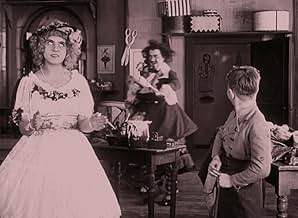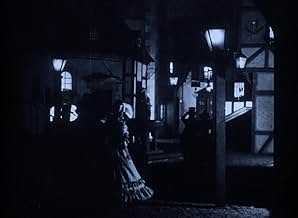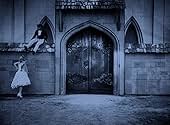AVALIAÇÃO DA IMDb
7,4/10
2,5 mil
SUA AVALIAÇÃO
Adicionar um enredo no seu idiomaForced into marriage by his uncle, a man decides to fool him by marrying a life-like mechanical doll instead.Forced into marriage by his uncle, a man decides to fool him by marrying a life-like mechanical doll instead.Forced into marriage by his uncle, a man decides to fool him by marrying a life-like mechanical doll instead.
Ernst Lubitsch
- Director in Prologue
- (não creditado)
Enredo
Você sabia?
- CuriosidadesAt one point Lancelot takes a heart out of the leg of his pants. This is an allusion to the German expression 'Das Herz ist mir in die Hose gerutscht' (my heart slid into my pants) which is equivalent to 'to have one's heart in one's boots'.
- Erros de gravaçãoLancelot shouts his alarm to a monk that he is being pursued by "40 women". However, about 20 women are seen on screen.
He says this because the butler earlier had announced "Forty women at the door!" It's an estimate as it's doubtful the butler made an individual count. Also, there is no "requirement" that all referenced individuals must appear on screen.
- Citações
Baron von Chanterelle: [on Lancelot's wedding night] Do you need any more pieces of advice?
Lancelot: No thanks, I have an instruction manual.
- ConexõesFeatured in Cinema Europe: The Other Hollywood (1995)
Avaliação em destaque
All cinema is artificial, and there is no getting away from this no matter how much of a realist you try to be. And while authenticity and naturalistic performances are a necessity for drama, there are some types of picture in which a deliberate flaunting of artificiality is not only acceptable, it is a positive benefit.
By this point in his career, German comedy director Ernst Lubitsch had developed a unique brand of slapstick, the hallmark of which was absurdity and exaggeration. In Lubitsch's world, almost anything can happen, and often does. The stories he dreamed up with his regular collaborator Hanns Kraly were always whimsical and fairy tale-ish, but the Doll is perhaps their most fantastical of all. In it we have a lifelike mechanical doll, and a flesh-and-blood woman pretending to be the doll. Rather than go overboard trying to make this look as convincing as possible, Lubitsch takes things the other way, and stages the whole thing in a phoney and theatrical land, complete with wooden sets, painted backdrops and pantomime horses. In such a setting, the premise of the picture becomes workable.
Aside from this, the comic stylings of the early Lubitsch farces were becoming increasingly refined. As usual there are lots of jokes based around ridiculous numbers of people doing the same thing in unison, or the expressions of characters in reaction. Here Lubitsch shows the confidence to have many of these gags play out in long, unbroken takes, with hilarious results, such as the long shot of Lancelot being chased round the town by a huge gang of women, followed by his elderly uncle, followed by a servant with the uncle's medication. Often the careful placement of actors means our attention is drawn to the right spot at the right time, as oppose to overdoing a gag with a jolting cut. An example of this is the uncle's servant's very funny reaction to Lancelot's suggestion that the uncle get married. Lubitsch has the servant to one side of the screen, where it seems natural for him to be, but closest to the camera so his face is clear and we instantly notice when his expression begins to change.
As the eponymous doll, we have here another triumphant performance from Ossi Oswalda. While individual actors were used almost like cogs in Lubitsch's machine, there is no denying that Oswalda was surely a great comedienne in her own right. Here she shows impeccable control and timing, as she is forced to instantaneously snap in and out of being herself and acting as the doll. She also has a lot of fun pulling faces in this one. Honourable mentions go to Hermann Thimig, who is clownish enough to make a lead man in this silly setting, and Gerhard Ritterband, who despite being a youngster manages to steal every scene he is in. It's a shame these two did not have more distinguished screen careers, but of course it's worth bearing in mind that many of these players were more successful on the stage.
Speaking of which, it's possible that some viewers might be put off by the theatrical artifice of this picture. There is a rather depressingly naïve school of thought among some cineastes that film is film and theatre is theatre, and for film to make itself like theatre is to somehow straitjacket itself. But as we have seen, Lubitsch's creation of a self-confessed unreal world has given him greater freedom in staging his bizarre humour. Another German director, Fritz Lang, used a similar approach in his films of the 20s and early 30s albeit for a very different effect, whereby he created macabre and stylised art deco cities in which all kinds of comic-book adventures could take place. And in the Doll, when we see characters sleepwalking over rooftops or being carried away by a bunch of helium balloons, it is reminds me more than anything of the world of cartoons, in which the only limitation is the skills and imagination of the animators. With pictures like this, Lubitsch was really setting his genius free.
By this point in his career, German comedy director Ernst Lubitsch had developed a unique brand of slapstick, the hallmark of which was absurdity and exaggeration. In Lubitsch's world, almost anything can happen, and often does. The stories he dreamed up with his regular collaborator Hanns Kraly were always whimsical and fairy tale-ish, but the Doll is perhaps their most fantastical of all. In it we have a lifelike mechanical doll, and a flesh-and-blood woman pretending to be the doll. Rather than go overboard trying to make this look as convincing as possible, Lubitsch takes things the other way, and stages the whole thing in a phoney and theatrical land, complete with wooden sets, painted backdrops and pantomime horses. In such a setting, the premise of the picture becomes workable.
Aside from this, the comic stylings of the early Lubitsch farces were becoming increasingly refined. As usual there are lots of jokes based around ridiculous numbers of people doing the same thing in unison, or the expressions of characters in reaction. Here Lubitsch shows the confidence to have many of these gags play out in long, unbroken takes, with hilarious results, such as the long shot of Lancelot being chased round the town by a huge gang of women, followed by his elderly uncle, followed by a servant with the uncle's medication. Often the careful placement of actors means our attention is drawn to the right spot at the right time, as oppose to overdoing a gag with a jolting cut. An example of this is the uncle's servant's very funny reaction to Lancelot's suggestion that the uncle get married. Lubitsch has the servant to one side of the screen, where it seems natural for him to be, but closest to the camera so his face is clear and we instantly notice when his expression begins to change.
As the eponymous doll, we have here another triumphant performance from Ossi Oswalda. While individual actors were used almost like cogs in Lubitsch's machine, there is no denying that Oswalda was surely a great comedienne in her own right. Here she shows impeccable control and timing, as she is forced to instantaneously snap in and out of being herself and acting as the doll. She also has a lot of fun pulling faces in this one. Honourable mentions go to Hermann Thimig, who is clownish enough to make a lead man in this silly setting, and Gerhard Ritterband, who despite being a youngster manages to steal every scene he is in. It's a shame these two did not have more distinguished screen careers, but of course it's worth bearing in mind that many of these players were more successful on the stage.
Speaking of which, it's possible that some viewers might be put off by the theatrical artifice of this picture. There is a rather depressingly naïve school of thought among some cineastes that film is film and theatre is theatre, and for film to make itself like theatre is to somehow straitjacket itself. But as we have seen, Lubitsch's creation of a self-confessed unreal world has given him greater freedom in staging his bizarre humour. Another German director, Fritz Lang, used a similar approach in his films of the 20s and early 30s albeit for a very different effect, whereby he created macabre and stylised art deco cities in which all kinds of comic-book adventures could take place. And in the Doll, when we see characters sleepwalking over rooftops or being carried away by a bunch of helium balloons, it is reminds me more than anything of the world of cartoons, in which the only limitation is the skills and imagination of the animators. With pictures like this, Lubitsch was really setting his genius free.
- Steffi_P
- 15 de jan. de 2010
- Link permanente
Principais escolhas
Faça login para avaliar e ver a lista de recomendações personalizadas
- How long is The Doll?Fornecido pela Alexa
Detalhes
- Tempo de duração1 hora 6 minutos
- Mixagem de som
- Proporção
- 1.33 : 1
Contribua para esta página
Sugerir uma alteração ou adicionar conteúdo ausente

Principal brecha
By what name was A Boneca do Amor (1919) officially released in India in English?
Responda













